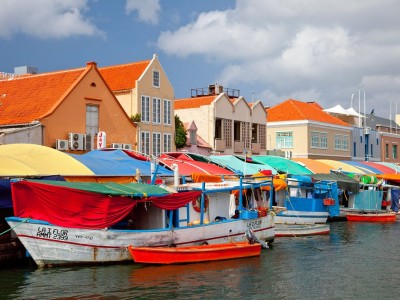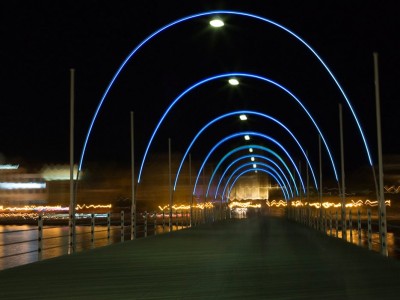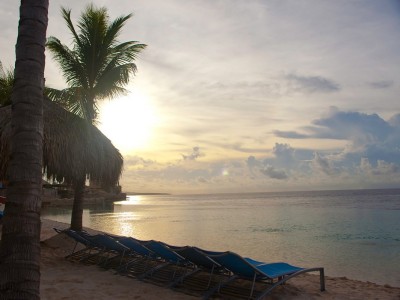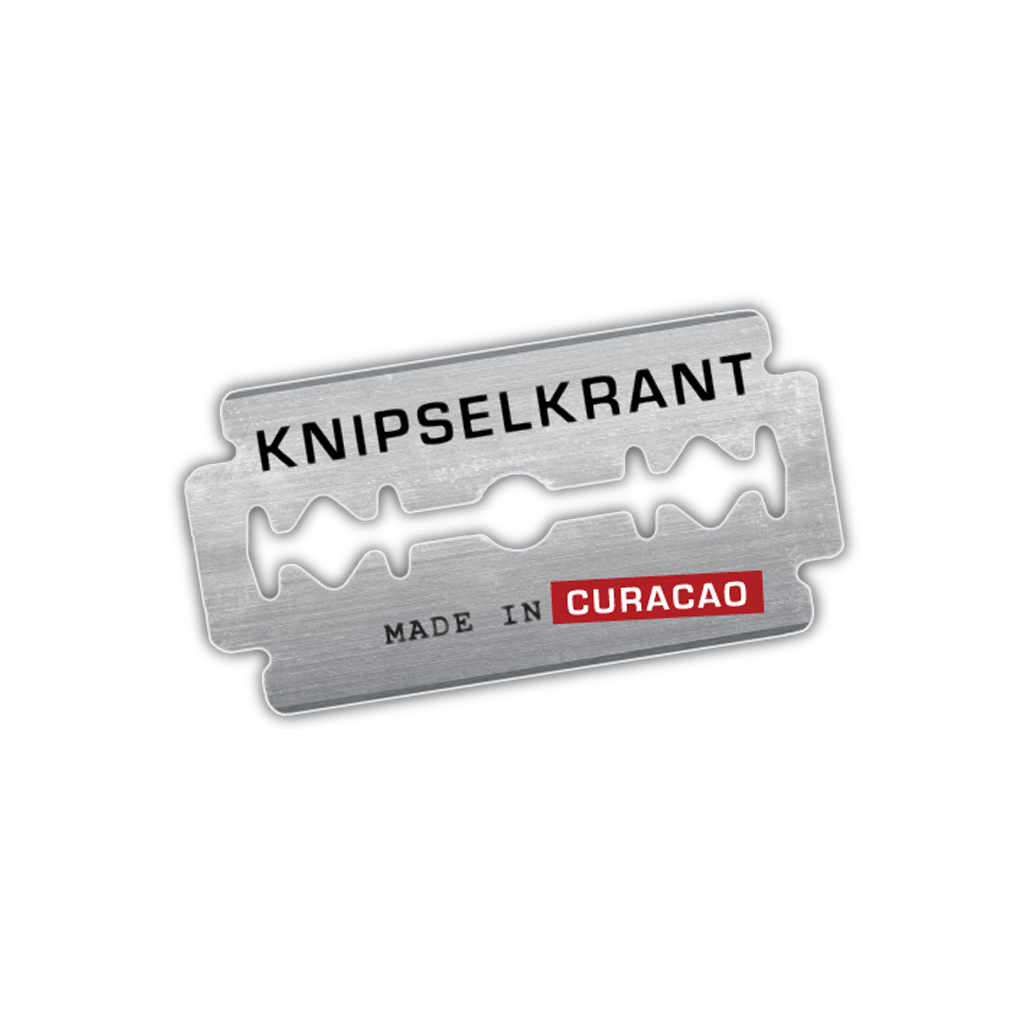By Lilit Marcus for Conde Nast Traveler

Curaçao is known for its gorgeous beaches. But there’s plenty more to do there than just catch rays, including new history-focused museums, a unique food culture, and a UNESCO-listed historic downtown.
When most people think of the Caribbean, they think of sandy white Bahamian beaches. But Curaçao and its siblings Aruba and Bonaire, which make up the Netherlands Antilles (more commonly known as the ABC Islands) are closer to South America than to the United States. As a result, many North Americans opted for closer cruise ship ports of call—but recently, that’s started to change. Although Curaçao was often dwarfed by Aruba and its world-famous beaches, the island is now coming into its own and is easier to access than ever. Air Canada began offering direct flights from Toronto to Willemstad, Curaçao’s capital, on January 1; JetBlue launched nonstops from New York last year. And the island is heavily investing in tourism: new museums and hotels have opened in the past few months, and the tiny airport (it currently has half a dozen gates) is due for an expansion in 2016. It seems like every day brings a new hotel or restaurant to the island, but don’t be overwhelmed by the sudden range of options—this is the very best of where to eat, stay, and play in Willemstad.
Eat
The Floating Market: Curaçao’s closeness to Venezuela results in more than just friendly political relations. Every weekday, fishermen from the country dock their boats in a specially designated spot on the water in downtown Willemstad; boats pull in as early as 5 a.m., and almost immediately people begin to walk up to check out the wares. Negotiations happen in multiple languages (mostly in Spanish, but English and Curaçao’s native Papiamentu are also well-represented) and currencies (guilders, dollars, and bolivars). Look for citrus fruits, avocados, honey, bananas, tuna, and mahi-mahi (usually called “dorado”). Don’t be surprised if you see a chef from your hotel here checking out the catch of the day to bring back to the kitchen.
Gouveneur de Rouville: Some of the native dishes of the Antilles are done to perfection here, including karni stoba (beef stew with plantains and vegetables) and keshi yena (a ball of Edam cheese stuffed with chicken and savory ingredients like olives). Choose from a list of European and South American wines, and try to get a seat on the balcony, which has a perfect view of the St. Anna Bay and, at night, the lit-up Queen Emma Bridge. A warning, though: Curaçao has a healthy business in selling Cuban cigars to American tourists, so you’re likely to be sitting near a guest who’s smoking one.
Plasa Bieu: To truly eat like a local, visit this low-key, unassuming food hall near the Floating Market, where a woman named Yvonne runs the show. Take a look at the day’s offerings as they boil away on the stovetops, then order from Yvonne or her English-speaking granddaughter Stephanie. Even on a blisteringly hot day it’s worth trying iguana stew (the reptile’s meat is considered an aphrodisiac), which is best paired with lemon water. The market is covered, but the open lattice-work walls mean plenty of sun will still get in, so refresh your SPF before eating. Although the market is casual, it is restaurant-style, so grab a seat and let someone bring over your food and utensils.
Play

Historic Willemstad: Downtown Willemstad, with its Dutch and Portuguese-inspired structures, was declared a UNESCO World Heritage Site in 1992. The colorful rows of houses in bright blues, yellows, and reds are being restored piecemeal, so a walk down any given block will give you both treasures and diamonds in the rough. Most of the historic houses are now government-owned and house municipal offices, meaning that quite a few are free and open to explore during the day. The capital is divided into two main sections on opposite sides of St. Anna Bay: Punda (“The Point”) and Otrabanda (“The Other Side”). The Queen Emma bridge (the three main bridges in Willemstad are named for Dutch queens, owing to its colonial legacy) connects the halves, then “floats” to one side several times a day in order to let ships pass through. Grab a beer at the waterfront Iguana Cafe and watch the boats pass by. If you’re lucky and the bridge is only going to be closed for a few minutes, you might be allowed to stay on it as it moves.
Punda Museum: As Curaçao changes and grows, some locals want to make sure they preserve the island’s heritage. The new Punda Museum, which opened in December 2014, is a one-room repository of old photos and memorabilia alongside a scale model of Willemstad dating from the 1960s. The collection is lovingly maintained, but it’s hard to appreciate without context—ask the chatty owner/operator to show you around. (Hanchi di Snoa 1-5)
Mikvé Israel-Emanuel: This synagogue, believed to be the oldest in the western hemisphere and colloquially known as “the snoa,” is a house of worship as well as a museum tracing the history of the island’s Jewish community, which began with Spanish and Portuguese Jews who fled Iberia during the Inquisition. The major photo op here is the synagogue’s floor, which is made of sand imported from Israel. Visitors who are interested in learning more about Curaçao’s Jewish heritage should sign up for a full tour, which includes a trip to the Jewish cemetery, whose oldest tombstones date to the 1500s. (Hanchi di Snoa 29)
Shete Boka National Park: Lying beachside or poolside is a great way to relax, but if you want a fuller sense of Curaçao’s natural beauty, head to Shete Boka, whose name translates to “Seven Mouths” or “Seven Inlets.” The word “dramatic” seems insufficient to describe this park, where waves crash into the rocky, angular volcano-formed inlets so grandly that they look like geysers. It’s a popular spot for scuba divers, who can check out the detailed coral formations just below the surface.
Stay

For a long time, hotels in Curaçao catered to specific demographics—this one was all Dutch, that one all Venezuelan—but the uptick in tourism is bringing different nationalities together.
Renaissance Resort & Spa: The Renaissance is located on a buzzy block full of shops and restaurants, but at night all you’ll hear is the gentle sound of crashing waves. In the morning, the Nautilus restaurant serves up some of the best pumpkin pancakes (a traditional Curaçaoan snack, they’re made with mashed pumpkin in the batter) in town, and in the afternoon its slightly pistachio-hued infinity pool is the perfect place to relax and enjoy a pineapple smoothie. When the sun fades a little in late afternoon, head across the street to the Dutch-built Rif Fort, climb to the top, and enjoy sweeping, unobstructed views of the sea and of downtown.
Kura Hulanda Hotel & Spa: Not many hotels can say that they have a museum on their grounds, but Kura Hulanda—Papiamentu for “Dutch courtyard”—is not your typical hotel. The museum, formerly a wealthy estate, documents the history of the slave trade in the West and the stories of the African diaspora. The surrounding Colonial-era buildings have been converted into upscale rooms, each with its own personality—think brightly colored bed linens, hand-carved teak furniture, and artwork by some of the contemporary African artists featured in the museum.
Baoase Resort: This five-star resort, which was named to Condé Nast Traveler’s Hot List when it opened in 2010, is wedged between downtown Willemstad and the Caribbean sea. It has a distinctly Asian design aesthetic, with Hindu and Buddhist sculptures and paintings throughout the property. Its 23 rooms and villas offer the privacy of a secluded beach as well as easy proximity to Punda’s nightlife and restaurant scene. You can visit “Little Curaçao,” an uninhabited island about 25 miles southeast of Curaçao, for picnicking and swimming via the resort’s private boat.
Bron: Conde Nast Traveler

